Share this Post
DISCLOSURE
I traveled to Japan in November of 2018 in order to appear on the TV show 'Who Wants to Come to Japan'! I was invited by the producers and my travel and costs were covered, however I was NOT asked to share any posts about it with my readers. Instead, I'm simply doing so because it was an amazing adventure, and I want to tell you all about it!
If you missed Part One, you can find it here. To see all of the posts in this series, click here.
As I explained in Part 1, I recently returned from an incredible, once-in-a-lifetime trip to Japan, where I appeared on the TV show 'Who Wants to Come to Japan' (世界ニッポン行きたい人応援団). I traveled to Japan in order to learn more about two of my favourite Japanese foods: ponzu shoyu and yuzu - and I was not disappointed! The itinerary was kept a secret by the producers, so every stop and experience was a surprise and an adventure. I'll be sharing more posts in the future about the individual stops, along with information I learned, recipes I've developed, and more. Be sure to subscribe for updates to make sure you don't miss out on anything new. I hope you'll enjoy this little look at my trip - and do be sure to check back regularly, as I'll be linking to relevant new posts and features from here as they're written.
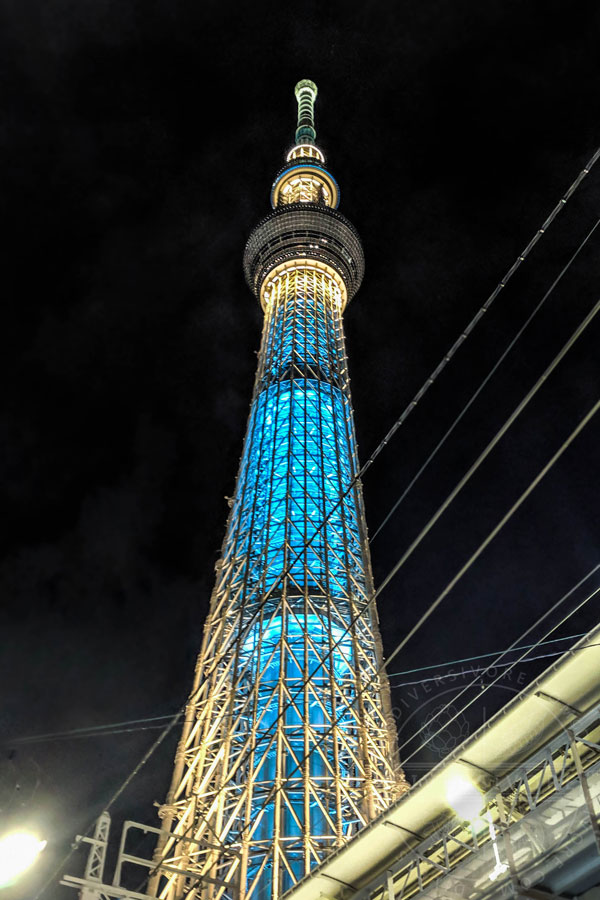
Tokyo Skytree - the single most heavily edited picture on Diversivore. I was in a hurry. At least it's not a food photo, right?
Tokyo (Part 1)
Some scheduling constraints on my end meant that I had to fly out of Vancouver on November 1st, rather than October 31st. Because of the day lost traveling and filming commitments we had an extremely brief stop in Tokyo to start the trip.
I'm not kidding when I say brief. Here's how it went: the crew picked me up in the airport in the late evening. We drove to the Tokyo skytree, put on some special badges, and were quickly whisked through the back entrances to a large grocery store complex somewhere underneath. Honestly, I don't even really know where we were. I think it was a depachika (I'll be writing a LOT more about those later), maybe in Solomachi mall. The trip was so brief that I managed one (1) not-so-good phone picture of the skytree, as you can see above. It has been extensively reworked in Photoshop. Best if viewed on a low res, early 2000s smart phone. While squinting.
So why did we race off to a grocery store? Why, to see ponzu of course! Here in Canada, the selection of ponzu available on many store shelves leaves a fair bit to be desired. But I was quickly shown to an entire wall of ponzu. A wall! And what a wall. As you can from the photo below, I was pretty impressed.
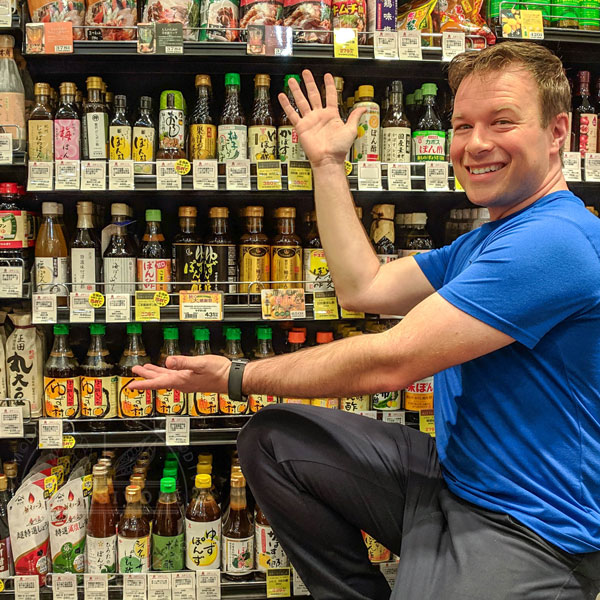
Ponzu posing. Pay attention to the ponzu, not to the greasy looking dude who had been awake for 24 hours at this point.
What were these ponzu sauces like? How different were the many varieties from one another? What kinds of recipes could I prepare with them?
NO IDEA, because it was time to go. Off to the hotel, where I collapsed into a bed that was far cleaner than I. Early the next morning, it was off to Haneda airport, and off to the next stop. Tokyo, we hardly knew ye. But fret not my friends, because when we finished up shooting I spent three days on my own in Tokyo, and I more than made up for the brevity of this first stop. But for now, on to new places!
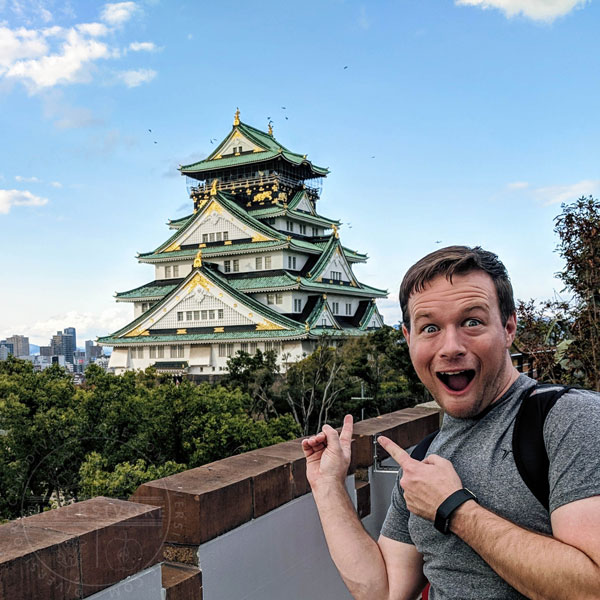
Osaka Castle. I mostly walk around making this face at things. I mean, it's a nice castle.
Osaka!
Oh man, I like this town.
Osaka - capital of Kansai, historic port city, economic heart of Japan, and home to some of the best food in the whole country. Osaka was long called 'Japan's kitchen,' because of it was central to food (and other) trades, and because the cuisine of the region reflected its status as a busy, vibrant, metropolis. Out on the streets, you can't help but notice how different Osaka feels compared to Tokyo. It's got a more 'out-there,' rough-around-the-edges sort of vibe. The busy Dōtonbori district is absolutely awash with bright neon and gigantic three-dimensional signs, many of which advertise local culinary specialties. It definitely feels very different from the more staid and subtle store-fronts and eateries that abound in capital city to the north.
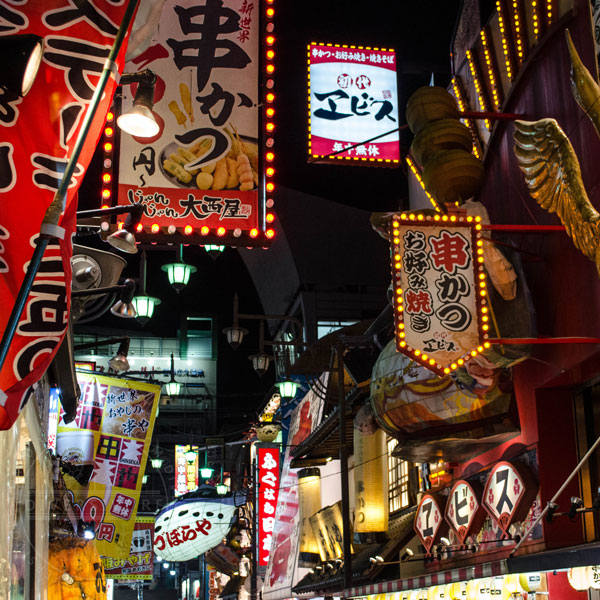
Osaka isn't exactly going for subtle.
But the food. Oh the food. If you're in Japan and you like to eat, you owe it to yourself to go to Osaka. The city has a culinary reputation that is both well-deserved and impossible to truly capture in writing. A number of famous Japanese culinary specialties originated in Osaka (or were perfected there, if you ask the local residents). Whether you want okonomiyaki or takoyaki, tonkatsu or kushikatsu, Osaka has what you're craving (especially if you're craving all of those).
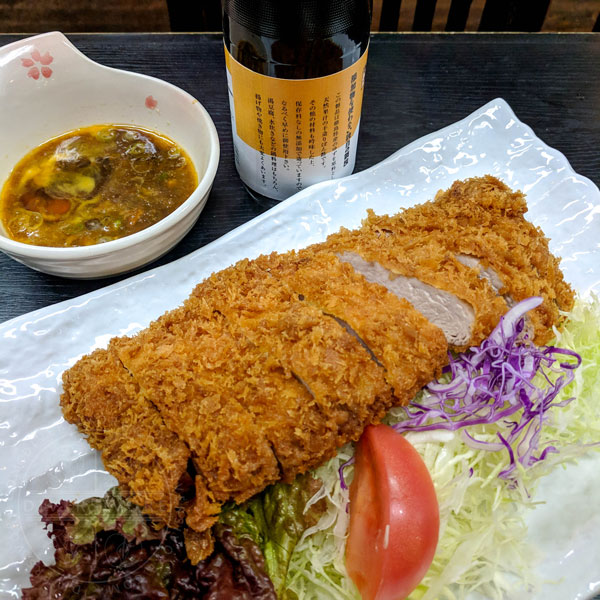
They were worried I might not want to eat it because of the raw egg. Hahahahahahahaha... ahhhhh. Good times.
So why were we in Osaka, you ask? For the food of course! Specifically, to meet some of the incredible, dare I say legendary ponzu makers that call the city home - and to taste some of the amazing dishes that Osaka chefs have been crafting with that most citrus-y of Japanese sauces. Case in point: that tonkatsu that you just scrolled past. I hope you paused long and hard on that one. I can't begin to tell you how perfect that tonkatsu was. Crispy and rich, yet light. And the sauce in the corner? Why that's ponzu shoyu mixed with raw egg. Let me tell you folks, that was an epiphany. If you get a chance to watch the episode and see me thoroughly enjoying that meal, please rest assured knowing that I did not need to ham up my reaction in the slightest. That was pure, deep-fried heaven.
That wasn't the only ponzu-based treat I enjoyed of course, but I've got to save some tidbits for an upcoming post, right? I will tell you a bit more about the ponzu itself though.
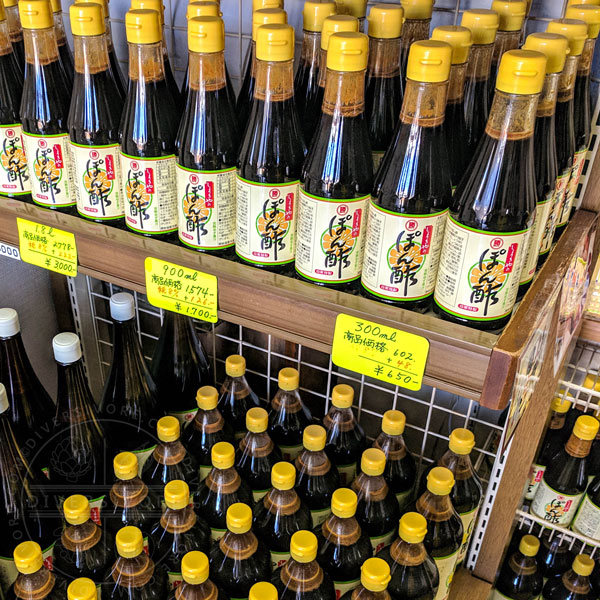
Not enough ponzu. Never enough ponzu.
Making ponzu was incredible. The Tanaka family of the award-winning Syokiya (Shoukiya) Ponzu (勝貴屋) was so kind and generous with their time, and they shared a lot of amazing tricks and secrets with me (including some I promised not to share - I have been privy to some serious ponzu magic). I was amazed by the care and dedication that went into making their ponzu. I tried to earn my keep in the form of manual labour too - I put a lot of labels and caps on those bottles. But honestly, I think I'll have to make a trip back some time to do another few hundred, because I'm still indebted to them for sharing their shop, their food, and their amazing ponzu with me. I can't wait to take what I've learned and pass it along (well, the non-top-secret stuff anyway) to you with my own ponzu recipe. Here's the original version - the one that got me to Japan in the first place. I'll be making changes and writing a new post in the future. I hope you'll join me then.
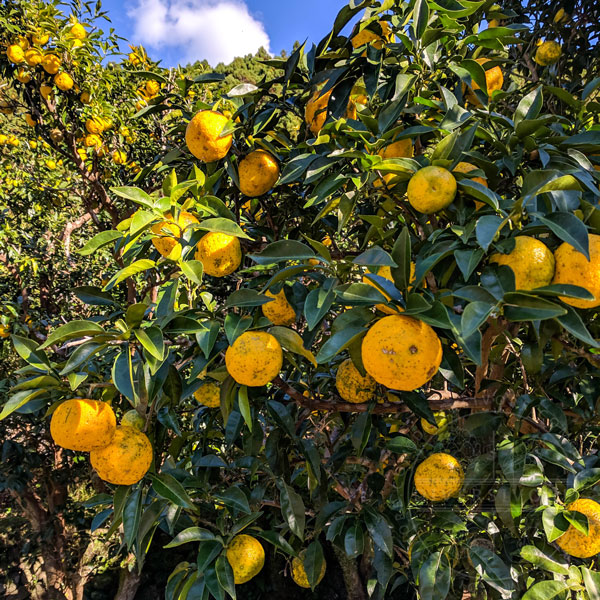
A yuzu grove in Kochi. I would have frolicked through here if it weren't for the thorns.
Kochi!
Osaka and Tokyo were both incredible, but Kochi prefecture on Japan's Shikoku island was an amazing, wildly different world altogether. The entire prefecture has a population of about 750,000, about half of whom are in Kochi city - a far cry from Osaka's 2.7 million or Tokyo's astonishing 9.3 million. The region is decidedly rural and agricultural, and let me tell you, there is a LOT of yuzu. In fact, the prefecture is the leading yuzu producer in the country. I went from the yuzu-less world of Canada to literally swimming in yuzu in Kochi. No, I am not misusing the term literally. I swam in an onsen filled with yuzu. I don't have any pictures (I was in a tub, wearing a towel - hard to carry photography gear), but if you can catch the show on TV Tokyo... well, please be gentle.
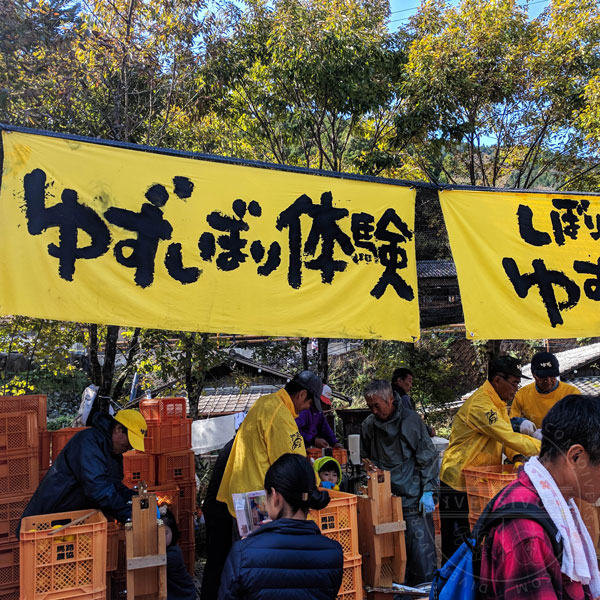
The Kochi Yuzu Festival. If it's possible to put yuzu into food, it'll be here. And then that food will be in me.
We headed out into the mountains to the tiny, beautiful village of Umaji in order to join the annual yuzu festival that was in full swing. So much yuzu. Honestly, I wish I could just bottle the smell in the air and carry it with me everywhere. We ate yuzu ramen, drank gokkun (a delicious honey-yuzu drink), pressed fresh yuzu juice, and basically just yuzu'd our minds out. If I'd stopped then and there I would already have considered my Japanese citrus experience to be an incredible one, but had a lot more to do and a lot more to try.
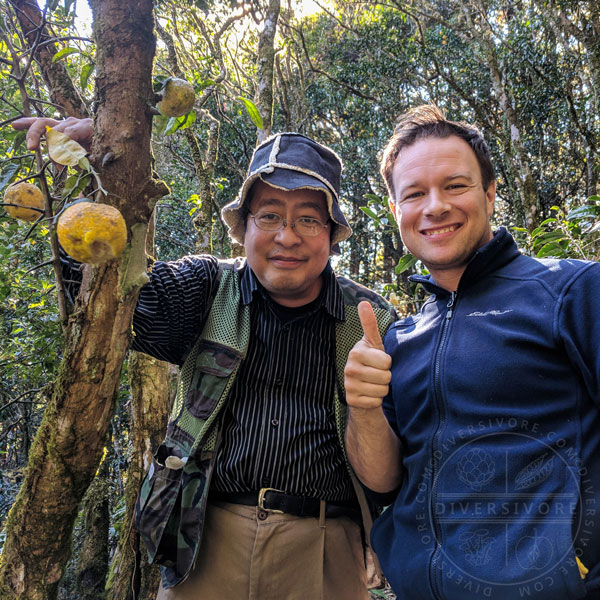
When this man tells you to suck the juice out of a yuzu while it's still hanging from the tree, you listen.
Learning about yuzu firsthand was every bit as amazing as I hoped it would be. Yuzu is an incredibly fragrant, complex citrus, and working with the fresh fruit really gave me a sense of the possibilities that I could explore with it. The man in the picture above is Kawashima-san, and he has got to be the most yuzu-loving guy on earth. In fact, Kawashima-san is yuzu crazy. His words, not mine - but I'm perfectly happy to agree (and to jump on board the yuzu crazy train). He did a great deal to popularize yuzu outside of Japan, including working with the late great Chef Joel Robuchon. He also picks and tends some of the rarest citrus in the world - wild mishō (seed-grown) koboko yuzu from tall trees in the mountains. Most yuzu is grown on dwarf root stock, making it much easier to pick, bu the wild seed grown yuzu trees deep in the hills are quite tall and tough to get to. A ladder was involved. As was a hard hat. There are silly pictures. Can't wait to share them with you. Kawashima-san was incredibly kind to take us to these trees, and then to take us all in to his home to feast and celebrate with his wonderful family.
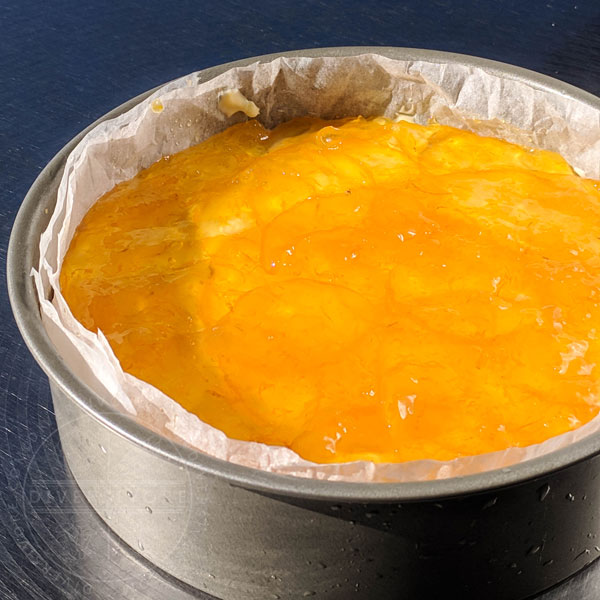
You know what they say - the best cake is the one you make yourself in an empty hotel kitchen after hours using a bag of yuzu that were gifted to you at a festival along with a mishmash of ingredients and cooking utensils that you, your translator, and an assistant producer bought at three different stores.
So what do you do when people bend over backwards to help you out? Well, you make them a cheesecake for starters. A no-bake yuzu cheesecake. And you make it in... a hotel kitchen, late at night, while an amazing film crew (and my fantastic translator) pitch in. As silly as this might sound, making and gifting that cheesecake was one of the best things I did in Japan. I'll work up the recipe to share with you all - though I'm going to have to come up with some interesting citrus alternatives in order to avoid making it an $80 cake.
Funnily enough, after telling everyone in Japan that I could never find yuzu in Canada, I came home and found it for the first time ever in my local Japanese grocery store. I was floored by the timing, but I'm afraid I didn't buy any - they were selling for an astonishing $7.50 Canadian (about ¥600) EACH. No more yuzu baths for me I suppose.
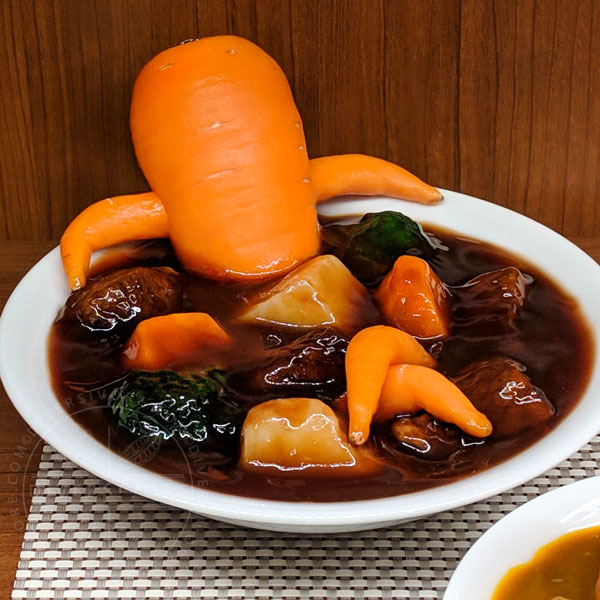
I feel like this plastic replica carrot chilling in his own replica stew carries deep wisdom. He has no worries. Not a carrot all.
Tokyo (Part 2)!
After we finished filming I headed back to Tokyo to start a little mini-adventure of my own. But this has already turned into more of a mega post, rather than the fun little post I originally imagined, so I'm going to leave you with a short teaser about my time in Tokyo. After all, it's Tokyo - there was a lot to do, and I've got a lot to tell you about.
What did I do in Tokyo? Well you'll have to come back later for another one of these Diversivore in Japan posts for the details. But how's this for starters:
- Walking the floor of the new Toyosu market (not entirely sure if I was supposed to be there or not...)
- Depachikas, depachikas, depachikas
- The most expensive cantaloupe you've ever seen
- An entire street dedicated to cooking gear (and plastic food, like the chillin' carrot dude above)
- Food. So much food. So, so much food.
I hope you've enjoyed these posts, and the introduction to my Japan trip. I'm going to be sharing more and more content over the coming weeks and months, and I hope you'll join along with me. If you're new to Diversivore - welcome! And I hope you'll come find me on Facebook, Instagram, and Twitter. If you do I promise to keep showing you pictures of food.
Cheers.
Share this Post


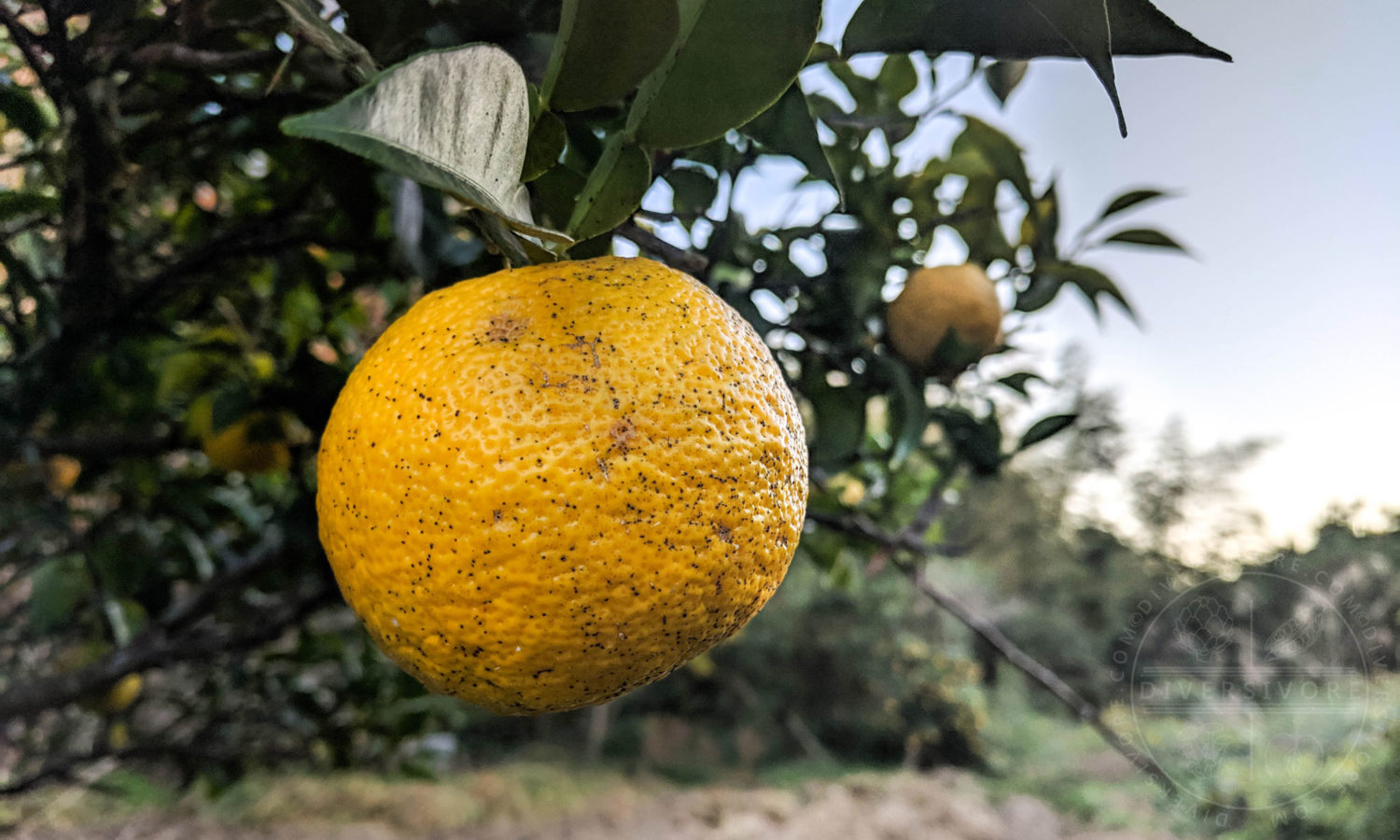
Comments
Hey Sean, I currently live in Japan and just watched your episode of “Who Wants To Come To Japan?” Out of curiosity, I wanted to know how your ponzu making has changed once you returned to Canada, so I did a Google search and found this site. Did the advice you received in Japan from the ponzu experts help you perfect your ponzu? I have a 9 month old son and was inspired by your passion for providing your children with amazing home cooking. Thanks for these wonderful posts.
Hi James! I’m so glad you saw the episode! I’ll be honest with you – I haven’t actually made a batch of ponzu since I got back two months ago… partly because I’ve been busy, but mostly because I came back with a whole bunch of amazing ponzu that was given to me. Haha. But I’ve already got a lot of pointers and tips that I’m looking forward to implementing, and I’ll be experimenting and adapting my recipe a lot more soon. I came to realize that my recipe is perhaps a bit more dashi-heavy and less sharp tasting than a lot of the good ponzu that I tried in Japan, and I got some great tips on how to bring a sharper taste in without making it overly sour (boiling the vinegar helps). I don’t know yet whether I’ve perfected my ponzu – or if I’ll ever feel that way – but I certainly feel like I’ve got the experience I need to make it as good as I can possibly get it!
I’m glad to hear that you were inspired by my cooking for my family. They mean the world to me, and I want them (and all kids!) to grow up with access to food that’s good for their minds and bodies. I think growing up with good food and good food education makes a world of difference.
Cheers, and thanks so much for taking the time to comment!
Hi Sean, my wife watches the show all the time and when your episode came on she wanted to buy ponzu from the first shop you visited. Funny enough in a Google image search your blog post came up. Always so happy seeing people’s love of Japan get rewarded on this show. Congrats, looked like a great time.
Hi Bryan! I am SUPER late responding to you here (sorry about that), but thanks for stopping by to comment! I did indeed have an incredible time. Life’s been pretty busy, but I’m looking forward to sharing some more of my adventures here on Diversivore soon – as well as a new ponzu recipe! And if you and your wife do make it to Osaka, I whole-heartedly recommend making it to the ponzu shop I visited!